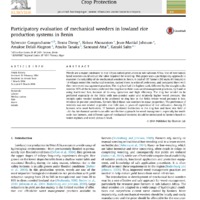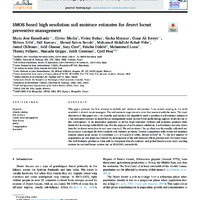Recherche
2 items
Participatory evaluation of mechanical weeders in lowland rice production systems in Benin
Weeds are a major constraint to rice (Oryza sativa) production in sub-Saharan Africa. Use of mechanical hand weeders could reduce the labor required for weeding. This paper uses a participatory approach to examine the suitability of six mechanical weeders in Benin. A total of 157 farmers (93 male, 64 female) in 14 villages tested the mechanical weeders, ranked them in order of preference, and compared them with their own weed management practices. The ring hoe had the highest rank, followed by the straight-spike weeder; 97& of the farmers preferred the ring hoe to their own weed management practices, by hand or using traditional hoe, because of its easy operation and high efficiency. The ring hoe tended to be preferred especially in the fields with non-ponded water and relatively higher weed pressure. The straight-spike weeder tended to be preferred to ring hoe in the fields where weed pressure is less, whereas in ponded conditions, farmers liked these two weeders in equal proportion. The preference of weeders was not related to gender, rice field size, or years of experience of rice cultivation. Among 23 farmers who used herbicides, 17 farmers preferred herbicides to the ring hoe and have rice field of >0.5 ha. Mechanical weeders can offer an effective approach for weed management, especially for smallscale rice farmers, and different types of mechanical weeders should be introduced to farmers based on water regimes and weed pressure level.
SMOS based high resolution soil moisture estimates for desert locust preventive management
This paper presents the first attempt to include soil moisture information from remote sensing in the tools available to desert locust managers. The soil moisture requirements were first assessed with the users. The main objectives of this paper are: i) to describe and validate the algorithms used to produce a soil moisture dataset at 1 km resolution relevant to desert locust management based on DisPATCh methodology applied to SMOS and ii) the development of an innovative approach to derive high-resolution (100 m) soil moisture products from Sentinel-1 in synergy with SMOS data. For the purpose of soil moisture validation, 4 soil moisture stations where installed in desert areas (one in each user country). The soil moisture 1 km product was thoroughly validated and its accuracy is amongst the best available soil moisture products. Current comparison with in-situ soil moisture stations shows good values of correlation (R > 0.7) and low RMSE (below 0.04m3 m−3). The low number of acquisitions on wet dates has limited the development of the soil moisture 100m product over the Users Areas. The Soil Moisture product at 1 km will be integrated into the national and global Desert Locust early warning systems in national locust centres and at DLIS-FAO, respectively.

